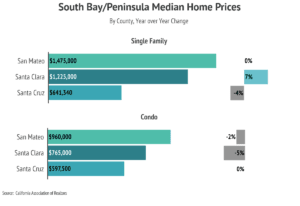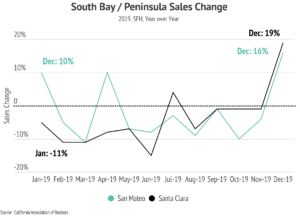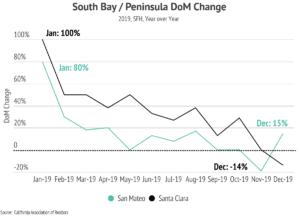San Jose Real Estate Market Report: February 2020
March 5, 2020
Real Estate

March 5, 2020
Real Estate


Welcome! In February’s newsletter, we review 2019’s biggest housing trends for the South Bay/Peninsula market and share our predictions for the year ahead. What will happen to home values in 2020? Will the South Bay/Peninsula become more or less affordable? Will interest rates go up? We’ll answer these questions and more in the following sections:
The 2019 Economy and Housing Market in Review
In 2019, the national economy grew at a steady, healthy pace. Employment remained near all-time lows, and gross domestic product (GDP), a measure of all goods and services produced during the year, grew by more than 2%. In spite of some potentially negative economic events, such as the trade war with China, the U.S. economy remained strong. The wage growth from October 2018 to October 2019 tied with the growth from April 2008 to April 2009 for the largest year-over-year increase in the past decade. The country also added 312,000 jobs in December, nearly doubling November’s job growth of 176,000.

The Federal Reserve surprised a lot of folks by reducing the federal funds rate three times in 2019 in order to maintain a thriving economy. The federal funds rate, which indirectly impacts a variety of consumer interest rates including credit cards and car loans, significantly affected mortgage rates in 2019.
After rising in 2018, last year’s mortgage rates returned to historic lows. Lower rates typically improve housing across all markets by giving home buyers access to cheaper financing.
In May 2019, home prices in the South Bay/Peninsula hit their yearly peak. While this trend is typical for the spring months, it was accelerated by falling rates. The chart below shows interest rates decreasing and home prices increasing.

In the latter half of the year, home prices pulled back from their spring highs while interest rates fell even lower, increasing affordability. In California, mortgage payments fell by 7.4%, the largest decline in the last five years. This drop more than offset the 10.3% increase in median home prices, and mortgage payments declined for nine consecutive months.

Like all major areas in California, the South Bay/Peninsula became more affordable. Looking at the chart below, you can see monthly mortgages decreased by over 11% in the Greater Bay Area, meaning lower interest rates benefited both buyers and sellers in 2019.

While a strong economy and greater affordability benefitted both buyers and sellers, median home prices had mixed results. For single-family homes, for example, prices remain unchanged in San Mateo, up 7% in Santa Clara, and down 4% in Santa Cruz. The Greater Bay Area has been one of the most unaffordable areas in the country for a long time, and 2019 helped to gently and slightly reverse this course.

Other key industry indicators for the South Bay/Peninsula showed strong end-of-year results. San Mateo and Santa Clara sales spent most of the year down but climbed to finish up by double digits compared to the prior year. This is due to December’s low interest rates.

A dramatic increase in sales in the latter part of the year impacted the months supply of inventory, a measure of how many months it would take to sell all the active listings on the market at the current rate of sales. In California, active listings fell for the seventh straight month, down 22.5% from December 2018. This was the fourth consecutive double-digit drop and the largest since April 2013.
In 2019, months supply for the South Bay/Peninsula plummeted to extremely low levels. In December, a month that usually has seasonally higher levels of supply due to slow holiday sales, supply tightened further to 1.1 months. In Santa Cruz, supply is down by nearly half from the year before.


Last but not least, in 2019 properties moved much slower for most of the year. Days on Market (DoM), the measure of how many days it takes for a seller to accept an offer from the first day of listing, started the year with homes taking almost twice as long to sell compared to the previous year. It took until the end of the year for the market to reverse course in Santa Clara, while DoM in San Mateo remained higher than the prior year.

This should be welcomed news for buyers especially in the fast-moving markets of San Mateo and Santa Clara.

In summary, the 2019 housing market for the South Bay/Peninsula became more affordable. While it’s still a sellers’ market, buyers benefited the most. Mixed results on median price data, lower supply levels, and slower DoM kept both buyers and sellers in check as they navigated an up and down year.
Economic and Housing Market Predictions for 2020
Now it’s time to think about the year ahead by weighing various factors that impact both the real estate market and the broader economy.

Happily, we’re not forecasting a recession in 2020. The stock market is doing well and the trade conflict has died down. While pundits do forecast GDP to decrease slightly and unemployment to increase slightly, we predict it will be another stable year for the housing market.
One of the burning issues in our 2020 forecast is what the Federal Reserve will do with interest rates over the next twelve months. For now, they say they have no plans either to cut or raise rates in 2020.

A stable economy and a low federal funds rate will keep mortgage rates low by historical standards. The California Association of Realtors (CAR) predicts that the average for 30-year-fixed rates will dip to 3.7% in 2020, down from 3.9% in 2019 and 4.5% in 2018.

CAR predicts that median home prices will be stable this year, with a slight increase of 2.5%. Affordability will remain unchanged, with 32% of California residents able to buy a median-priced home. Home sales are predicted to increase by 1%.
Like at the end of 2019, this year’s homebuyers will face a severe lack of supply, higher home prices, and greater competition. As Jordan Levine, Deputy Chief Economist of CAR, said during the fourth quarter of 2019:
“In some ways, the market is going to start looking like 2016—where inventory was very tight, the market was more competitive on the buyer’s side. That leads to more growth but it also limits the amount of sales because we have a significant dip in active listings. We are at the lowest level in almost eight years.”
In 2020, we believe the severe shortage of available housing will cause more residents to leave the state. According to CAR’s 2019 State of the Housing Market Study, 30% of sellers planning to repurchase said they will buy their next home in a state outside of California. This is the highest rate of prospective buyers moving out of state since 2005.
Median Price Predictions for All South Bay/ Peninsula Counties in 2020
The 2020 housing market for the South Bay/Peninsula will strengthen in favor of sellers, and both single-family homes and condos should increase in price. The following chart, based on CAR’s median price predictions for the upcoming year, shows we can expect prices finishing up 2.5% year-over-year:

As the new year gets underway, we remain committed to helping our clients achieve their current or future real estate goals. Our team of experienced professionals is ready and eager to talk in more detail about all the information we’ve shared here. We welcome you to contact us with any questions about the current market or to request an evaluation of your home or condo.
"*" indicates required fields
Stay Updated On Our Most Recent Blog Posts

Buyer's Real Estate Tips
Brian Ng | January 6, 2026

Real Estate
Brian Ng | September 5, 2024

Buyer's Real Estate Tips
Brian Ng | December 2, 2025

Buyer's Real Estate Tips
Brian Ng | December 2, 2025

Buyer's Real Estate Tips
Thao Dang Pham | December 2, 2025

Buyer's Real Estate Tips
Brian Ng | December 2, 2025
You’ve got questions and we can’t wait to answer them.